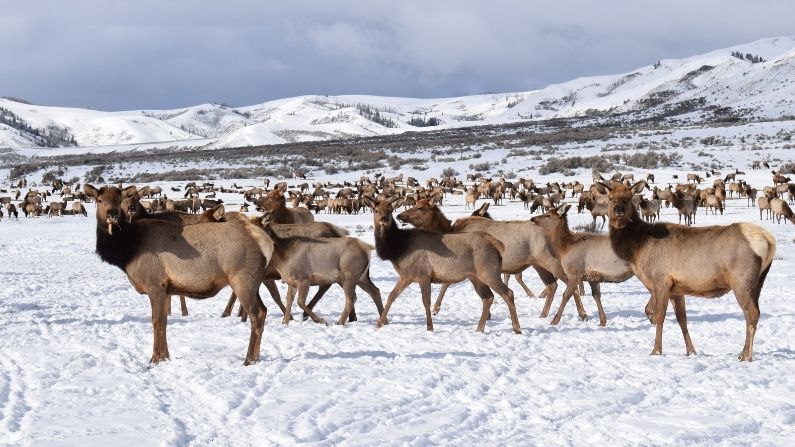During the winter months in the Gros Ventre Wilderness, Jay Hoggan’s mornings always start the same way. He harnesses up a team of horses to a large sled and directs them over to a mountain of hay, which is delivered by tractor at the start of the season. With the help of his daughter, Rita, Hoggan then loads the sleigh by hand with a few dozen bales and starts off into an open field, where nearly a thousand elk congregate. While Jay mans the horses, Rita uses a hatchet to break apart and unload each bale, one by one, off the back of the sleigh for the elk to eat.
Hoggan has been managing one of 22 feedgrounds owned by the Wyoming Game and Fish Department in Western Wyoming since 2006. It gets difficult at times, he said—try lifting an 80-pound bale when it’s 40 below out—but, it’s certainly never boring.
“On a clear day, you could see the Tetons right there,” Hoggan said. “I mean, look at that line out of elk. Isn’t that cool?”
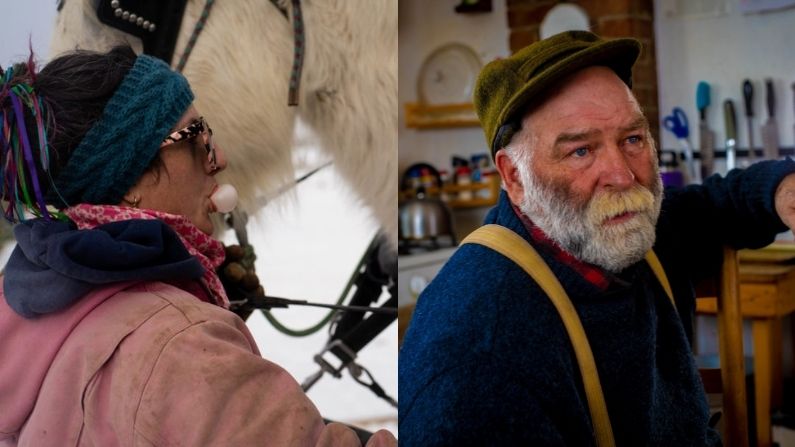
Rita (left) and Jay (right) Hoggan run one of Wyoming’s 22 elk feedgrounds during the winter season. (Emily Cohen/KHOL)
Humans have been feeding elk in the Jackson Hole region for over 100 years. The practice was put in place to separate wildlife from human agriculture and infrastructure. It also keeps elk alive when snow gets particularly deep in the wintertime, when they have less of the natural landscape to feed off of. Hoggan said he’s seen elk starve when they get stuck in deep snow.
“Them years that the winter’s deep, they need to be fed because more elk will die of starvation than they will [of] disease,” he said.
One of the most worrying sicknesses that plagues the state’s elk herds is Chronic Wasting Disease, or CWD. CWD was discovered in December for the first time in Wyoming’s feedground regions in Grand Teton National Park, just a stone’s throw away from the National Elk Refuge on the outskirts of downtown Jackson.
Similar to Mad Cow Disease, CWD is always fatal, and it spreads through the transmission of body fluids such as saliva or urine. Brad Hovinga, regional wildlife supervisor for the Jackson Region of Wyoming Game and Fish, said he believes the disease is here to stay.
“It is a slow-moving disease. It takes a long time to get where it’s going,” Hovinga said. “But the fact remains that Chronic Wasting Disease is here, and it’s probably not going away.”
Hovinga has been a part of the planning effort to deal with the potential spread of CWD at Wyoming’s elk feedgrounds for several years. CWD also affects other ungulates, like moose and deer, impairing the animals’ brains and spinal cords. Ben Wise is the Jackson Wildlife Disease Specialist for Wyoming Game and Fish, and he said he’s seen the disease’s effects on elk up close and personal.
“Their ears droop. They get a weird hair coat. They begin salivating and, yeah, it’s not a pretty disease,” Wise said. “It’s not a quick and kind of gentle death either.”
It can take up to two years before an animal succumbs to the disease, and in that time, they can spread it among their herd. Other local wildlife experts, including several biologists, have argued that the feedgrounds surrounding Jackson Hole provide perfect conditions for spreading the disease fast, and causing a potentially catastrophic epidemic. That’s why there are mounting calls, and lawsuits, demanding that Game and Fish close feedgrounds sooner rather than later. But Wise said that would be difficult to do.
“We can’t just stop feeding cold turkey,” he said. “The implications of that are dramatic. If we were to just stop feeding—shut the feedgrounds down tomorrow—we would be dumping a lot of elk into situations where we don’t have the ability to mitigate [or] mediate.”
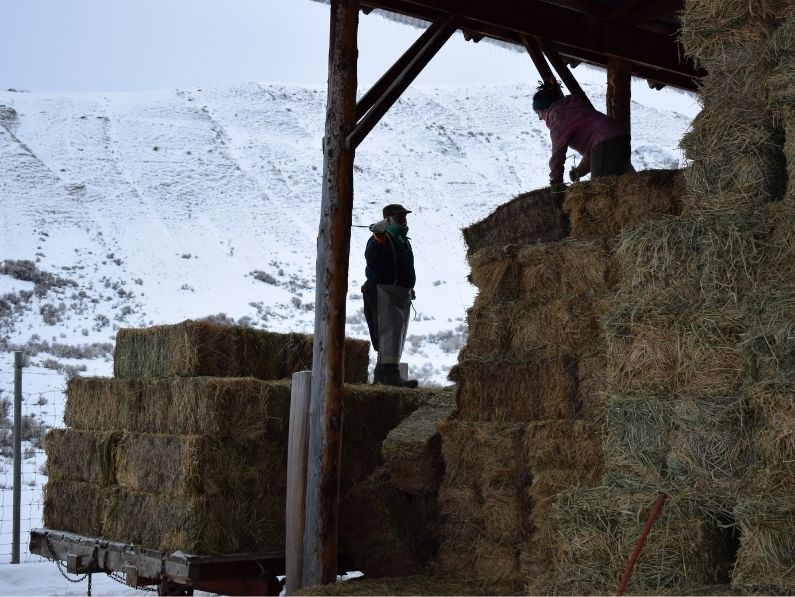
Rita and Jay Hoggan load up their sleigh in February 2021. (Will Walkey/KHOL)
More elk would be on roadways, for example, or getting into rancher’s hay. Or dying of starvation. So, Game and Fish has said it will likely be at least five to 10 years before any feedgrounds close. It seems like a lose-lose situation for nearly all parties involved, but experts like Wise and Hovinga are doing all they can to mitigate disease spread in the meantime. And it all starts back at the feedgrounds.
Hoggan’s well-oiled routine hasn’t deviated much over the past 14 years, but even that’s changing to accommodate for CWD risk. He and Rita now methodically drop hay bales one by one every few yards rather than all at once or whenever they can. Wise said that’s a deliberate technique.
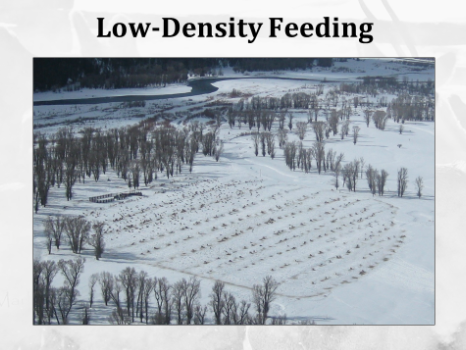
Wyoming Game and Fish uses a number of techniques, including low-density feeding, to try and keep elk spread out on its feedgrounds. (Courtesy of Ben Wise/Wyoming Game and Fish)
“It’s called low-density feeding,” he said. “The idea is if you spread the feed out in kind of a uniform pattern on a larger area, the rate of contact greatly decreases because elk aren’t just running up and down a single feed line there. They have options of other places to go.”
A lot of these techniques were implemented years ago to combat Brucellosis, another disease affecting elk, Wise said. In the spring, when south-facing slopes start to burn off and native foliage gets exposed again, feeders like Hoggan also start to drop off less hay.
“So, we slowly wean them off of supplemental feed as they begin using those native winter ranges more effectively throughout the spring,” Wise said.
And in some cases, like with two feedgrounds near Pinedale this year, the feedgrounds simply won’t open at all. Hoggan also said he’s noticed collaring on elk, with a color-coding system signifying where each animal was originally tagged, in order to monitor animal movements and get a better understanding of the greater Jackson herd as a whole.
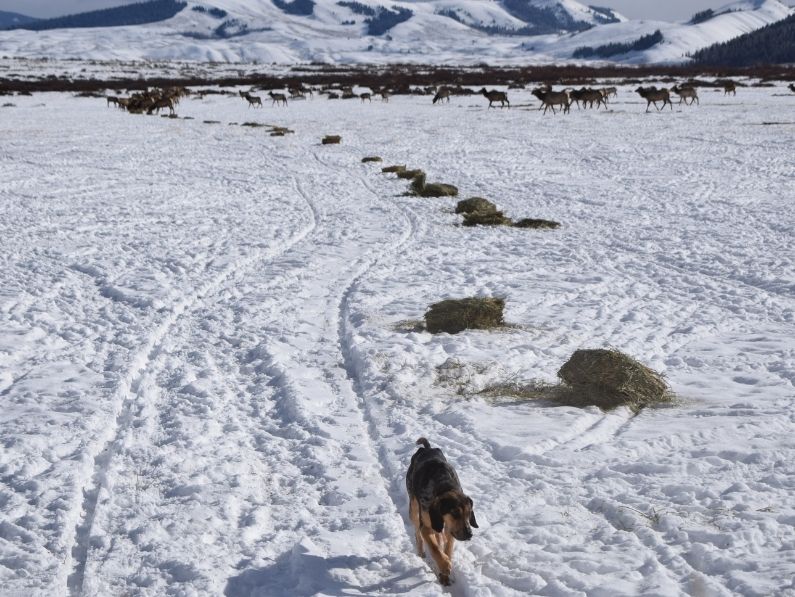
A line of hay is systematically dropped off Hoggan’s sleigh, with an elk herd in the background. (WIll Walkey/KHOL)
Game and Fish officials said the department tags 400-500 elk every winter. If a hunter shoots an elk, or if it dies in another way, the department will also retrieve, test, and dispose of it. Tens of thousands of samples have been collected from the Jackson elk herd, according to Wise. Sometimes, the department tests as much as 90 percent of all elk killed in a season in the region.
“By collecting those animals when they die, getting them off the feedground, and testing them, A) we know whether or not they’re positive. And B) we’re also keeping the feedground a lot cleaner,” Wise said.
Game and Fish is also trying to educate the public about its CWD management plan, and the department is scheduled to meet with major stakeholders and the public in the near future as more plans and techniques emerge. At the same time, state lawmakers are debating a bill that would define what would have to happen should an elk feedground need to be closed in the future. To Hovinga, that’s not such a bad thing.
“It’s an effort to try to make sure that all the right processes happen should there be a proposal coming from somewhere to close down,” he said.
Game and Fish and other major stakeholders like the Wyoming Livestock Board would have a seat at the table if it comes to closing feedgrounds, according to the bill. Most of the feeders he’s worked with, including Hoggan, have also been brought into the long-term management plan for CWD, according to Wise.
“By and large, every feeder we’ve worked with has bought into it,” he said. “They think it’s a good idea. They understand the science behind it.”
Still, Game and Fish concedes that CWD may continue spreading in Jackson Hole, just as it has in other parts of Wyoming and the intermountain west that don’t have feedgrounds. Hoggan said that’s because elk naturally come together in the wintertime.
“They’re going to congregate here just the same way with us. We’re going to go to where the lunch line is,” he said. “I mean, they might be on different ridges and stuff, but they’re still going to be together.”
Much like another certain virus we’re dealing with among humans, the question is how quickly—and whether at all—we can get CWD under control.
This story is Part 2 of KHOL’s coverage of elk feedgrounds in Wyoming. Learn more about the day-to-day life of Jay Hoggan and his daughter Rita in Part 1.
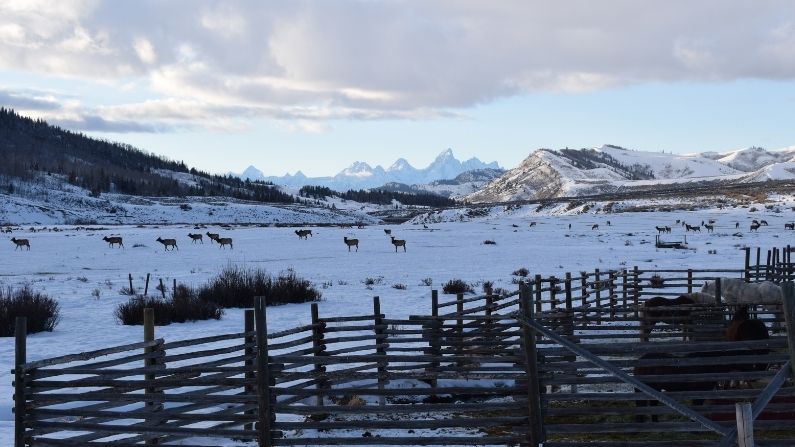
A view of the Tetons from one of Wyoming’s 22 elk feedgrounds, in the Gros Ventre Wilderness. (Will Walkey/KHOL)

